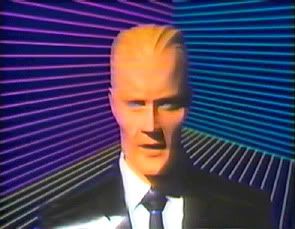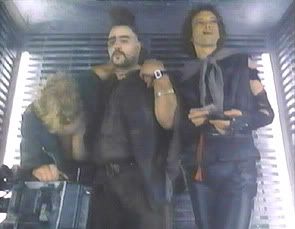 Max Headroom. You remember him, don't you? He was everywhere in the eighties. He had a couple TV shows, he was in commercials for New Coke (Ha!), appeared at the Superbowl, at Reagan's 1984 inauguration and even sang a new wave tune. Well, he didn't sing, he just stuttered his way across an old Art of Noise track, but it was a big hit anyway.
Max Headroom. You remember him, don't you? He was everywhere in the eighties. He had a couple TV shows, he was in commercials for New Coke (Ha!), appeared at the Superbowl, at Reagan's 1984 inauguration and even sang a new wave tune. Well, he didn't sing, he just stuttered his way across an old Art of Noise track, but it was a big hit anyway.Max began his career as a VJ on the BBC introducing Duran Duran videos and cracking wise in his synthesized staccato, making him a lot like Martha Quinn, but with a personality. But you can't just throw a computer-generated host (albeit a fake one) on Britain's TV screens and not expect people to ask questions. You might be able to get away with that in America (According to Jim has been on the air here for eight years and no one's so much as batted an eye) but across the pond, they're a curious lot.
In the UK, people wanted to know where this guy came from. So this film was produced to give him some back story. The result is an odd cross between Blade Runner and Network.
Edison Carter is the world's most famous reporter, working for Network 23. When he stumbles onto a story the network wants buried, Carter nearly ends up dead. It seems the Network's new advertising scheme, blipverts, are causing viewers to spontaneously combust. Need less to say, they can't allow this story to get out.
An overzealous computer engineer tries to put an end to Carter's snooping by bonking him on the head and selling his body to the local organ resale outfit. The sudden disappearance of Network 23's star reporter might arouse suspicions, so Carter's face and memory are dumped into a computer. The idea here being this simulacrum will take Carter's place and no one will be the wiser.
 Unfortunately, the new Carter is a hyperactive, glib chatterbox who bares little resemblance to his progenitor, or any actual person. Things go from bad to worse when the computer containing the new Carter falls into the wrong hands and the real Carter wakes up and escapes from the body bank.
Unfortunately, the new Carter is a hyperactive, glib chatterbox who bares little resemblance to his progenitor, or any actual person. Things go from bad to worse when the computer containing the new Carter falls into the wrong hands and the real Carter wakes up and escapes from the body bank.The computer falls into the hands of Blank Reg, a grizzled sixty-something punk with a pirate TV station broadcasting from an old Winnebago. Reg hooks up the computer and releases the creation onto the airwaves, and thus Max Headroom is born. "Max headroom" was the last thing Carter saw before blacking out, as he got his head smashed into a sign in a parking garage, and it's the first thing he utters when booted up. (Later in the TV series, the same thing happens to another character who takes on the name Ped Xing.)
So Network 23 has a whole mess of problems: Their advertisements are killing people. Carter is back from the dead and even more determined to find out what they're hiding. Max Headroom is loose and mouthing off, and pulling in excellent ratings.
20 Minutes into the Future is an interesting example of the early cyberpunk genre, a group of films that remains relatively small. This is probably the only cyberpunk film that is a comedy. There is some tension and drama, but most of the action is played for laughs. Max himself is essentially a wisecracker, and little is done to mold him into anything with more depth.
 Clearly the film owes plenty to Blade Runner and its dystopian landscape of urban decay. Max Headroom's London is a rotting, crumbling metropolis, overrun with homeless, and rife with Scottish organ thieves. It's certainly ahead of its time. Cyberpunk film really didn't come into its own until the mid-Nineties, with Johnny Mnemonic driving the proverbial nail in the coffin before the genre really got off the ground. It wasn't until The Matrix trilogy that cyberpunk gained any respect, and by then no one really cared, and certainly no one was calling it cyberpunk any longer.
Clearly the film owes plenty to Blade Runner and its dystopian landscape of urban decay. Max Headroom's London is a rotting, crumbling metropolis, overrun with homeless, and rife with Scottish organ thieves. It's certainly ahead of its time. Cyberpunk film really didn't come into its own until the mid-Nineties, with Johnny Mnemonic driving the proverbial nail in the coffin before the genre really got off the ground. It wasn't until The Matrix trilogy that cyberpunk gained any respect, and by then no one really cared, and certainly no one was calling it cyberpunk any longer.You know, it's hard to get too enthusiastic about a soulless world built on shallow simulation and instant gratification when you're actually living in one. But in 1985 a world of invasive technology, corrupt multinationals, and computer hackers seemed fun. Twenty-five years on, the novelty has worn off.
Despite being a bit ahead of the curve, this film is still a product of the times: The score is by Midge Ure of Ultravox. The computer graphics are decidedly Commodore 64. And Max, well, he's not even computer generated. He's actually Matt Frewer in prosthetic makeup. Technology in 1985 wasn't advanced enough to actually create a computer-generated person, so the filmmakers had to fake one.
There are none of the Eighties' hallmark Day-Glo headbands or parachute pants, but that's not dystopian. No, that's the stuff of utopia.
[Cross-posted.]
No comments:
Post a Comment